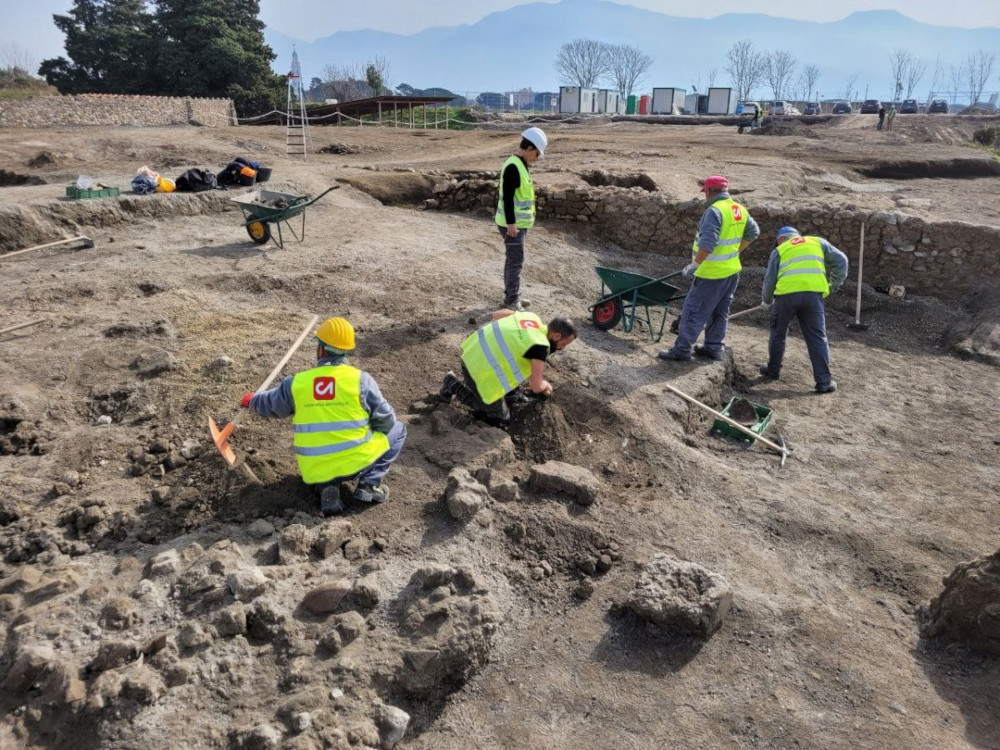In Pompeii, new excavations have begun in thecentral area of the site: an area that covers about 3,200 square meters, equal to almost an entire city block of the ancient city buried in 79 AD. The project is part of a broader approach that, developed during the years of the Great Pompeii Project, intends to rectify and solve the hydrogeological and conservation problems of the excavation fronts, that is, the boundary between the excavated and unexplored parts of the ancient city. The latter amounts to about 15 hectares of blocks and houses still buried under lapilli and ash, almost a third of the ancient settlement.
The approach of the new excavation, located in Insula 10 of Regio IX along Via di Nola, is the same as that already implemented in the excavation of Regio V during the years 2018-2020 under the direction of then-director Massimo Osanna. In addition to improving the conditions of preservation and protection of the millennia-old structures through an arrangement of the excavation fronts, which have always been elements of vulnerability due to soil pressure on ancient walls and stormwater runoff, the new excavations will use various archaeological professionals, including archaeologists, archaeobotanists, numismatic volcanologists, ancient topographers, as well as architects, engineers, and geologists, to draw the maximum amount of information and data from the stratigraphic survey operations.
“Excavating in Pompeii is a huge responsibility,” said Pompeii Archaeological Park director Gabriel Zuchtriegel. “Excavation is a non-repeatable operation; what is excavated is forever. So we have to document and analyze well every find and all the stratigraphic relationships and think from the beginning about how to secure and restore what we find.”
The excavation is still in its early stages, but the wall ridges of the upper floors of ancient buildings are already beginning to emerge, including a house, transformed in its later stages into a fullonica (laundry) and excavated as early as around 1912, and a house with an oven and upper cell. In even higher levels, archaeologists have documented a series of holes drilled into the ground in perhaps more recent years and presumably functional for the agricultural use of the land or perhaps related to the lapilli quarrying activities that the area underwent in modern times. Eighteenth- and nineteenth-century views show how the plateau above the excavations was used for various agricultural crops, including wooded areas and rural buildings, and farmers’ greenhouses were still present until 2015. A landscape, the historic one from the decades of Pompeii’s rediscovery, that the Park also intends to enhance and tell the story of through another project that aims to redevelop the green areas of the site and its surroundings. Just in these weeks, the procedure for selecting a partner to cultivate the Park’s vigente under a public-private partnership is underway, which envisions theexpansion of cultivated areas, and in the future also the establishment of olive groves, orchards and social gardens.
“The size of a disaster is also measured by whether it can be forgotten, whether it can fall into oblivion,” the director commented. “And that landscape of crops, woods and pastures that arose in the centuries after the eruption on the site of the ancient city is like a small comfort compared to the terrible tragedy of 79 AD that destroyed the entire city of Pompeii in two days. The memory of the tragedy faded, life returned. So much so that after excavations began in 1748, it took 15 years to realize that they were digging in Pompeii and not in Stabia.”
 |
| New excavations begin in Pompeii, in a large central area of the site |
Warning: the translation into English of the original Italian article was created using automatic tools. We undertake to review all articles, but we do not guarantee the total absence of inaccuracies in the translation due to the program. You can find the original by clicking on the ITA button. If you find any mistake,please contact us.